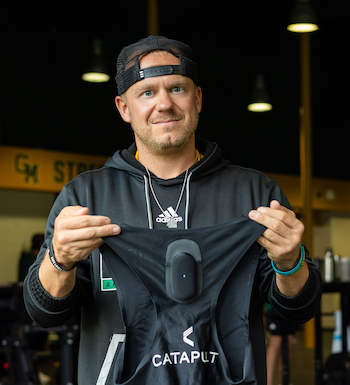Corey Dulak-Sigler said he doesn’t necessarily have a philosophy when it comes to athletic training.
Instead, George Mason University’s head strength and conditioning coordinator figures that “there’s a time and place for everything, and adjustments are the most important part.”

His study on the workload demands of Mason’s women’s lacrosse players falls squarely into that parameter.
“For me, in my realm of strength and conditioning, it helped validate what I was doing in the weight room to help the players keep those qualities that make them do well on the field, and make tweaks where I need to,” Dulak-Sigler said.
The study, titled “Analysis of Accumulated Workloads and Performance Testing Across a Collegiate Women’s Lacrosse Season,” was published in the Journal of Strength and Conditioning Research and is believed to be the first to focus solely on the training demands and in-season physical demands of Division I women’s lacrosse players, timely research given lacrosse's return to the Olympics in 2028.
Joining Dulak-Sigler as co-authors of the study are Margaret T. Jones, director of the Patriots Performance Lab; Andrew Jagim, director of sports medicine research at the Mayo Clinic Health System; Nicholas M. Kuhlman, a doctoral research fellow at the University of Connecticut; and Mason alumnus Jennifer B. Fields, PhD Kinesiology '20, an assistant professor of nutritional science at the University of Connecticut.
The study, conducted during the 2022 season, looked at the accumulated workload demands of players during games and practices to assess the most productive training for the athletes to meet the gameday workloads.
In a 16-week study, athletes were tracked on their total distance run, changes in direction, high speed distance, and heart rate.
This was done through Catapult load monitoring technology, a three-inch tall, one and a half-inch wide, half-inch thick device worn in a harness between the shoulder blades. It includes an accelerometer that monitors movements, a gyroscope that measures rotation, and a magnetometer that measures direction and orientation. A separate small device monitors heart rate.
The data is pinged to satellites and then to a central computer. A receiver can provide real-time data for use during games. But data from practices are generally accessed later through an app, where it was analyzed by Dulak-Sigler and Jones at the Patriots Performance Lab.
“We have a unique situation here at George Mason where the strength coach and scientists work together,” Jones said. “That’s not commonplace.”
That kind of collaboration is a hallmark of a Mason core value, which is to provide a positive and collaborative community that contributes to the well-being and success of every member.
But the information goes nowhere if coaches are not on board, Jones said.
Not an issue, Mason women’s lacrosse coach Kara Mupo said.
“Credit to Corey in that he has embraced this technology, and done a deep dive into it, more so than other people would, and he had an interest in working with us [the Patriots Performance Lab] to write this up,” Jones said. “So I don’t know if we didn’t have Corey if we would have been able to get this done.”
The lacrosse team is not the only Mason squad using Catapult. Women’s basketball and soccer and men’s basketball also use the system.
Faith Brown, the strength and conditioning coach for women’s basketball and volleyball, has also worked with Jones as lead author on several papers on load monitoring, with two more scheduled to be published.
Load monitoring and management will be key during basketball’s preseason, Brown said.
“That preseason period is meant to prepare the athletes for the demands of games, so we want to have practices where they experience higher loads than what they experience in games,” Brown said. “We want to make sure their bodies are comfortable and can withstand the stress.”
What did Dulak-Sigler find as he dug into the numbers? That the load training he used with the lacrosse team was appropriate for the loads the athletes faced during games.
“We looked at all the load monitoring of the in-season, and it ended up great,” he said. “No one got worse. Everybody stayed the same or better. It was more of a validation that we were doing things correctly.”
“Without Corey being a major resource, breaking down practice games and really educating me and my staff, we would have this amazing resource we wouldn’t be using to its full advantage,” Mupo said. “We say all the time, success is measured in the win column. But we can’t get the wins unless we’re healthy and safe. That’s the measurement we use.”
Related News
- April 25, 2024
- March 21, 2024
- March 1, 2024
- February 28, 2024
- January 10, 2024
